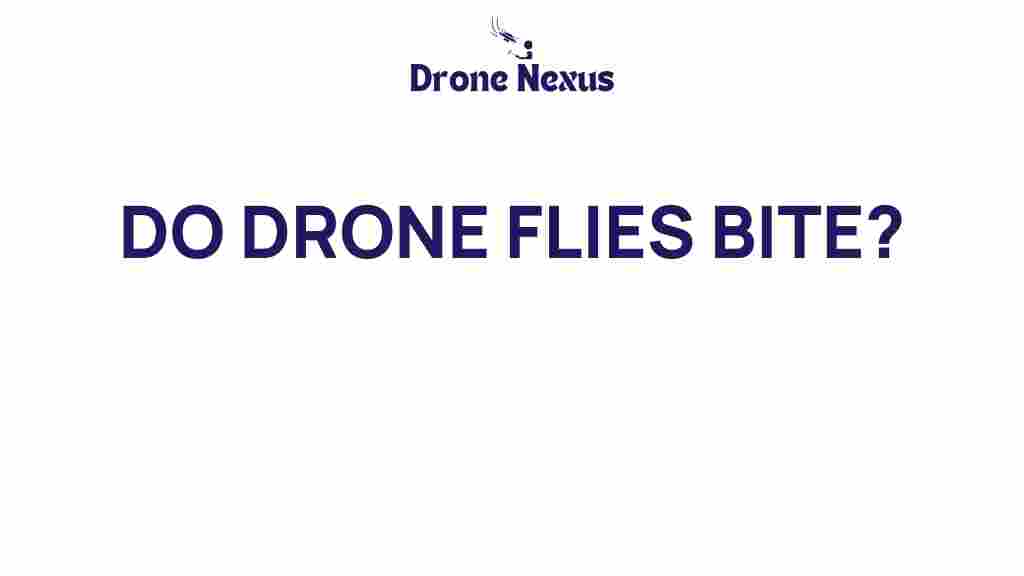Do Drone Flies Bite? Unraveling the Buzz Behind These Creatures
When we think about flies, our minds often drift to the pesky housefly or the irritating mosquito. However, there’s a lesser-known group of insects that piques the interest of many: drone flies. In this article, we will explore the fascinating world of drone flies, their behavior, and, most importantly, answer the burning question—do drone flies bite? Join us as we unravel the buzz behind these intriguing creatures.
What Are Drone Flies?
Drone flies, scientifically known as Eristalis tenax, belong to the family of hoverflies. They are often confused with bees and wasps due to their yellow and black striped bodies and their buzzing sound. But despite their resemblance to these stinging insects, drone flies are harmless and play a crucial role in our ecosystem.
Physical Characteristics
Drone flies have several distinctive features:
- Size: Typically, drone flies measure between 0.5 to 1 inch in length.
- Coloration: They have a striking yellow and black striped body, similar to that of a bee.
- Wings: Their wings are large and transparent, enabling them to hover in one spot while feeding.
Habitat and Distribution
Drone flies are found in various habitats, including gardens, fields, and wetlands. They thrive in areas abundant with flowers, where they can easily access nectar. These flies are prevalent in Europe, North America, and parts of Asia.
Do Drone Flies Bite?
The question on everyone’s mind remains: do drone flies bite? The answer is a definitive no! Drone flies do not possess the necessary mouthparts to bite or sting. Unlike mosquitoes or other biting flies, drone flies are gentle creatures that do not pose any threat to humans or animals.
Understanding Their Behavior
Drone flies are often seen hovering around flowers due to their feeding habits. Here’s what you need to know about their behavior:
- Nectar Feeding: Drone flies primarily feed on nectar, making them important pollinators in the ecosystem.
- Hovering Ability: They are known for their ability to hover in mid-air, which is vital for accessing nectar from flowers.
- Mimicry: Their resemblance to bees is a survival strategy known as mimicry, helping them avoid predators.
The Benefits of Drone Flies in Ecosystems
While drone flies may not bite, their presence is immensely beneficial to our environment. Here are some of the key advantages:
Pollination
Drone flies are excellent pollinators. As they move from flower to flower collecting nectar, they inadvertently transfer pollen, aiding in plant reproduction. This process is crucial for the growth of many fruits and vegetables, contributing to biodiversity.
Natural Pest Control
Drone fly larvae are known to feed on decomposing organic matter and can help control pest populations in gardens and agricultural settings. By promoting a healthy ecosystem, they play a significant role in maintaining the balance of nature.
How to Attract Drone Flies to Your Garden
If you’re interested in inviting drone flies into your garden, there are several steps you can take:
- Plant Diverse Flowers: Choose a variety of flowering plants that bloom at different times throughout the season.
- Avoid Pesticides: Pesticides can harm beneficial insects like drone flies. Opt for organic gardening methods instead.
- Provide Water Sources: A shallow water source can attract drone flies and provide hydration.
Troubleshooting Common Misconceptions
Despite their harmless nature, misconceptions about drone flies persist. Here are some common myths debunked:
Myth 1: Drone Flies Are Bees
Reality: While drone flies mimic bees in appearance, they do not belong to the bee family and do not sting.
Myth 2: They Spread Diseases
Reality: Drone flies do not carry diseases that affect humans. They are safe to have around.
Myth 3: They Are Pests
Reality: Drone flies are beneficial insects that contribute to pollination and pest control, rather than being pests themselves.
Conclusion
In conclusion, drone flies are fascinating creatures that play an essential role in our ecosystem. They do not bite or sting, making them harmless companions in our gardens. By understanding their behavior and benefits, we can appreciate the vital contributions they make to pollination and natural pest control.
Encouraging drone flies in your garden not only supports biodiversity but also enhances the beauty of your outdoor space. So, the next time you see a drone fly buzzing around, remember, they are here to help, not to harm!
For more information on attracting beneficial insects to your garden, visit this guide on gardening. If you’re looking to learn more about the fascinating world of insects, check out this external resource.
This article is in the category Nature and created by DroneNexus Team
